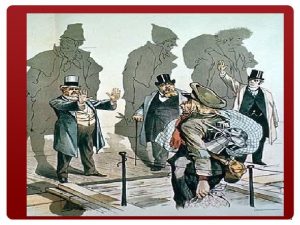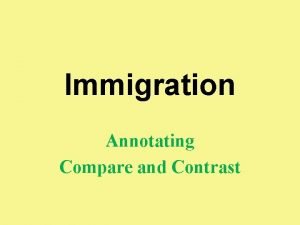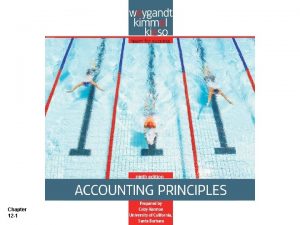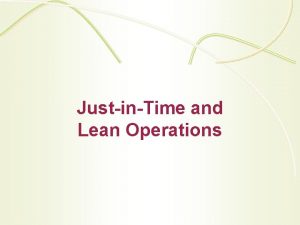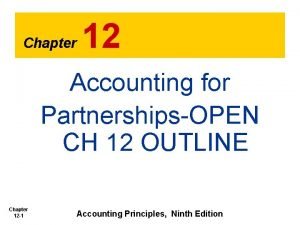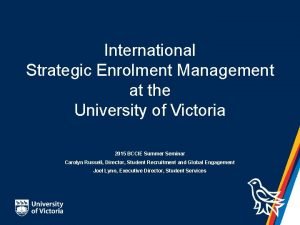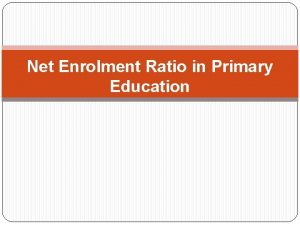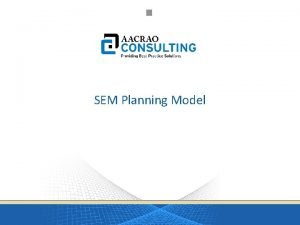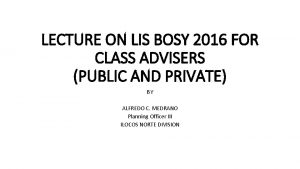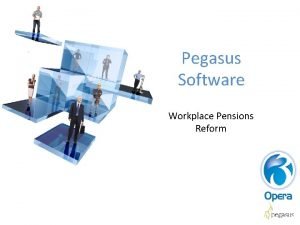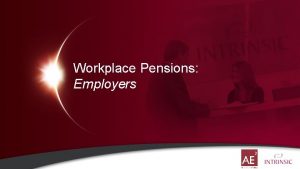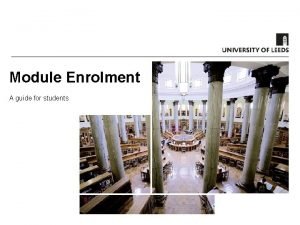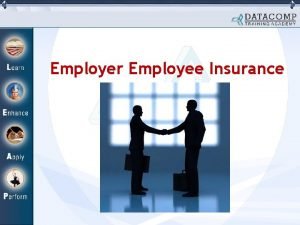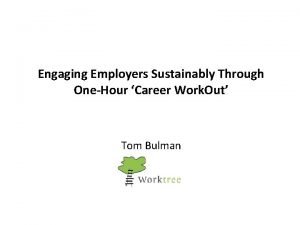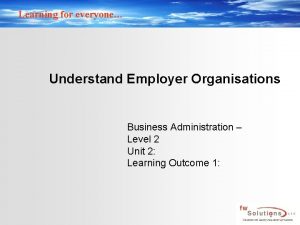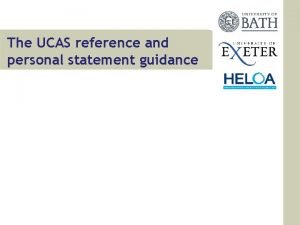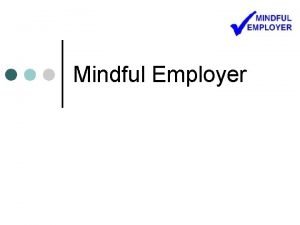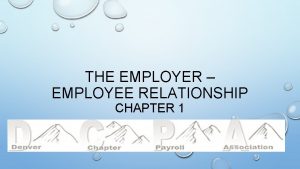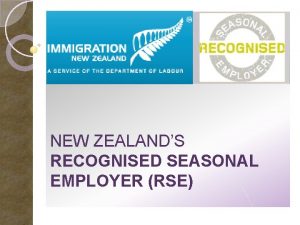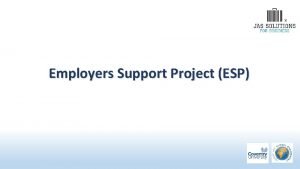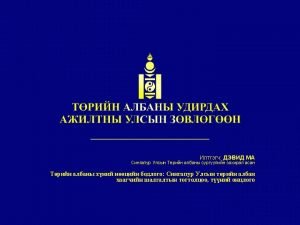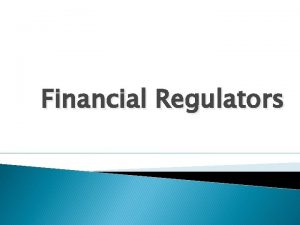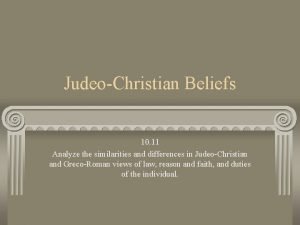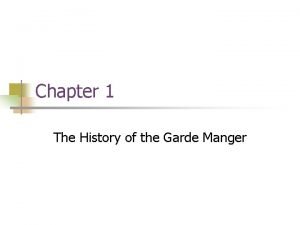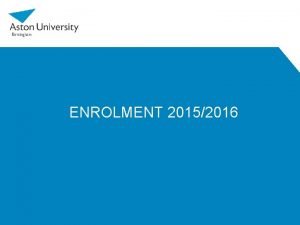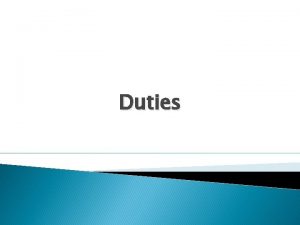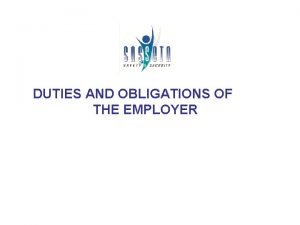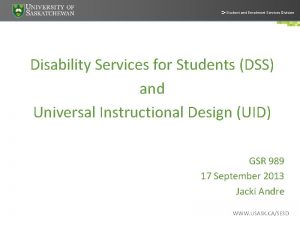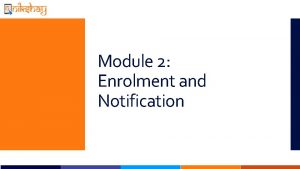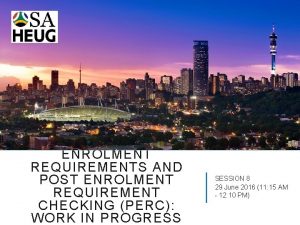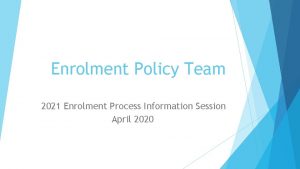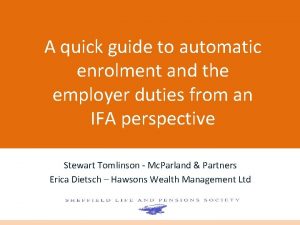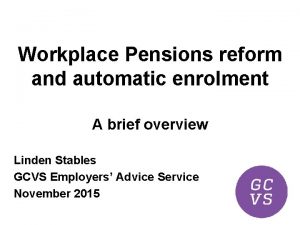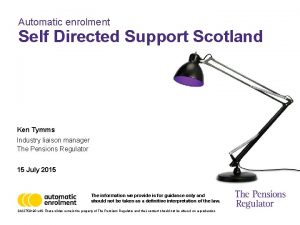Automatic enrolment The employer duties Island Partnerships Scilly




























































































- Slides: 92

Automatic enrolment The employer duties Island Partnership’s Scilly Business Week Porthmellon Enterprise Centre - Isle of Scilly Neil Esslemont Head of industry liaison 8 March 2016 The information we provide is for guidance only and should not be taken as a definitive interpretation of the law. DM 3493888 v 1 These slides remain the property of The Pensions Regulator and their content should not be altered on reproduction.

Topics • Introduction to automatic enrolment • Details of the employer’s duties • Pension schemes and how to find one DM 3493888 v 1 These slides remain the property of The Pensions Regulator and their content should not be altered on reproduction.

Automatic enrolment An introduction • Why automatic enrolment was introduced and the story so far • The employer duties DM 3493888 v 1 These slides remain the property of The Pensions Regulator and their content should not be altered on reproduction.

What is automatic enrolment? The law on workplace pensions has changed. • Every employer with at least one member of staff has new duties, including putting those who meet certain criteria into a workplace pension scheme and contributing towards it. • This is called automatic enrolment. – It’s called this because it’s automatic for members of staff - they don’t have to do anything to be enrolled into a pension scheme. – It’s not automatic for employers. They need to take steps to make sure staff are enrolled. DM 3493888 v 1 These slides remain the property of The Pensions Regulator and their content should not be altered on reproduction.

Why is automatic enrolment being introduced? There are currently four people of working age for every pensioner by 2050 there will be just two. Past and predicted trends in the life expectancy period of 65 year old men and women in the UK as of 2004 and 2010 DM 3493888 v 1 These slides remain the property of The Pensions Regulator and their content should not be altered on reproduction. 7 million people are undersaving

The story so far More than 100, 000 employers have automatically enrolled their staff There are over 6 million people enrolled into automatic enrolment pension schemes Approximately 100, 000 employers to stage in the first three months of 2016 DM 3493888 v 1 These slides remain the property of The Pensions Regulator and their content should not be altered on reproduction.

Staging • The employer duties apply to each employer from their staging date: – the duties apply to all of the employer’s staff from that date. • An employer’s staging date will be based on the PAYE scheme or schemes that were being used on 1 April 2012. – After 1 April 2012, any change to the PAYE schemes being used will have no effect on the staging date. • However, new employers* will go last, from May 2017. Large employers Oct 2012 Medium employers April 2014 Small/micro employers June 2015 New* employers May 2017 Do not assume you know your staging date - check this on our website *Employers that did not exist (or were not using a PAYE) as at 1 April 2012. Feb 2018 DM 3493888 v 1 These slides remain the property of The Pensions Regulator and their content should not be altered on reproduction.

Staging dates for new employers (post 1 April 2012) PAYE income is first payable in respect of any member of staff Staging date From 1 April 2012 up to and including 31 March 2013 1 May 2017 From 1 April 2013 up to and including 31 March 2014 1 July 2017 From 1 April 2014 up to and including 31 March 2015 1 August 2017 From 1 April 2015 up to and including 31 December 2015 1 October 2017 From 1 January 2016 up to and including 30 September 2016 1 November 2017 From 1 October 2016 up to and including 30 June 2017 1 January 2018 From 1 July 2017 up to and including 30 September 2017 1 February 2018 DM 3493888 v 1 These slides remain the property of The Pensions Regulator and their content should not be altered on reproduction.

Staging profile (excludes those without eligible jobholders and employers with no workers) About half a million employers staging in 2016, almost 100, 000 in Q 1 We estimate* that 65% of employers yet to stage will have full automatic enrolment duties * Based on age and earnings data from HMRC DM 3493888 v 1 These slides remain the property of The Pensions Regulator and their content should not be altered on reproduction.

Support for employers: Duties checker DM 3493888 v 1 These slides remain the property of The Pensions Regulator and their content should not be altered on reproduction.

Duties checker: Before you begin DM 3493888 v 1 These slides remain the property of The Pensions Regulator and their content should not be altered on reproduction.

Tell us if you run a business DM 3493888 v 1 These slides remain the property of The Pensions Regulator and their content should not be altered on reproduction.

Is your business still active? DM 3493888 v 1 These slides remain the property of The Pensions Regulator and their content should not be altered on reproduction.

Do you employ anyone? DM 3493888 v 1 These slides remain the property of The Pensions Regulator and their content should not be altered on reproduction.

See your staging date 1 DM 3493888 v 1 These slides remain the property of The Pensions Regulator and their content should not be altered on reproduction.

Your staging date DM 3493888 v 1 These slides remain the property of The Pensions Regulator and their content should not be altered on reproduction.

Do you employ anyone between 22 and SPA? DM 3493888 v 1 These slides remain the property of The Pensions Regulator and their content should not be altered on reproduction.

Do they earn more than £ 833 a month? DM 3493888 v 1 These slides remain the property of The Pensions Regulator and their content should not be altered on reproduction.

Employer classification DM 3493888 v 1 These slides remain the property of The Pensions Regulator and their content should not be altered on reproduction.

I am an employer who has to provide a pension xx DM 3493888 v 1 These slides remain the property of The Pensions Regulator and their content should not be altered on reproduction.

Steps for those who have to provide a pension DM 3493888 v 1 These slides remain the property of The Pensions Regulator and their content should not be altered on reproduction.

Details of the employer’s duties DM 3493888 v 1 These slides remain the property of The Pensions Regulator and their content should not be altered on reproduction.

Overview of legal duties and safeguards Automatic enrolment legislation gives employers a duty to: ü automatically enrol all staff who are eligible ü other staff, who have the right to ask to opt in or join a pension ü communicate to their staff ü manage opt outs and promptly refund contributions ü every three years, automatically re-enrol staff who are eligible ü complete a declaration of compliance with the regulator ü keep records ü maintain payments of pension contributions The employee safeguards mean that employers: must not induce staff to opt out or cease membership of a pension, and must not indicate, when recruiting new staff, that the decision to employ them will be influenced by whether or not they intend to opt out. DM 3493888 v 1 These slides remain the property of The Pensions Regulator and their content should not be altered on reproduction.

Check suitability of payroll and IT systems • Payroll software can help an employer carry out: – the assessment – enrolment – communications, and – calculation of pension contributions à If your payroll software does not do all of the above, non-payroll software or services could be used. • Some pension scheme providers offer some or all of these services. • You should plan to test these systems before they go live. • Employers have often found many errors in their staff records - so these should be checked for accuracy before staging. DM 3493888 v 1 These slides remain the property of The Pensions Regulator and their content should not be altered on reproduction.

Who is included in the automatic enrolment duty? A person may be subject to the automatic enrolment legislation if they are: • aged 16 to 74 (inclusive), and • work in the UK*. . . whether or not they are full time or part time, permanent or temporary. There may also be other people who are included: • overseas workers, who are considered ordinarily working in the UK*. However, the truly self employed are not subject to automatic enrolment. * the Channel Isles and the Isle of Man are outside the UK DM 3493888 v 1 These slides remain the property of The Pensions Regulator and their content should not be altered on reproduction.

What if someone says they are self-employed? • If someone working for you says they are self-employed, you should not assume that this person is exempt from automatic enrolment … unless they are a director of your company, as a director who is not working under an employment contract is exempt. • Otherwise, you should consider if the contract allows the individual to subcontract the work or freely substitute somebody else to do it … if so, then you will not have any automatic enrolment duties for the individual. • However, if the individual is normally expected to do the work themselves (unless they are unable to do it themselves, eg they are on holiday or sick) … then they are considered to have a ‘personal contract’ to perform work or services and the employer will need to judge whether or not the individual is doing the work as part of their own business. DM 3493888 v 1 These slides remain the property of The Pensions Regulator and their content should not be altered on reproduction.

Is someone working as part of their own business? If someone (who is not a director) considers themselves self-employed and has a ‘personal contract’: • The employer will need to consider whether the individual is working as part of their own business or not. • There a number of factors that will help decide this. Does the employer: – have control of the hours they work? – provide any employee benefits? – bear all the significant financial risks in carrying out the work (eg the individual is not financially responsible for their faulty work)? – consider the individual to be part of their own organisation? – provide what is required for the individual to carry out the work (eg tools)? If most or all of the above are true, it would be reasonable to consider that the individual is not undertaking the work as part of their own business and so are subject to automatic enrolment. • Otherwise, they are truly self-employed and are exempt. DM 3493888 v 1 These slides remain the property of The Pensions Regulator and their content should not be altered on reproduction.

Is a director subject to automatic enrolment? • A director of a company is not classed as a worker, unless • the individual works for the company under a contract of employment and • there is at least one other person working for the company under a contract of employment. • A director who is not working under an employment contract is never classed as a worker. • The exemptions can apply to more than one director working for the same company. DM 3493888 v 1 These slides remain the property of The Pensions Regulator and their content should not be altered on reproduction.

Example of sole employee/director exemption Type of work contract between the individual and this company Employer duties apply to this individual? Sole director/employee - Peter (who is a director of this company with an employment contract) X Additional director - Sarah (not on an employment contract) X Additional director - George (not on an employment contract) X Additional director - Linda (has a written contract of employment) √ (Peter* and Linda) *Now there are two directors with contracts of employment duties apply to both Peter and Linda. This would be the same even if Linda was not a director and was just an employee - Peter’s exemption would stop when she joined. DM 3493888 v 1 These slides remain the property of The Pensions Regulator and their content should not be altered on reproduction.

Are you considered the ‘employer’? Where someone: • is employed by you (ie they have a contract of employment with you), or • is directly contracted to perform work for you and you pay the individual: then you are considered to be the ‘employer’ (ie the ‘employer’ is the legal entity named in the contract). Otherwise: • if someone working for you is employed by another company (perhaps because they work for an agency or their own limited company), you will not be considered the employer and so will have no AE duties for them. • if someone working for you is paid for this work by another company or agency, that company will have the responsibility for any automatic enrolment duties, not yourself. DM 3493888 v 1 These slides remain the property of The Pensions Regulator and their content should not be altered on reproduction.

To tell us you are not an employer • If an employer does not believe they are an employer because: – it is a sole director company, with no other staff – it is a company with more than one director, where no more than one director has an employment contract – the company has ceased trading – the company has gone into liquidation or has been dissolved Tell us at Ø https: //automation. thepensionsregulator. gov. uk/notanemployer • The tool is not for employers who: – have no staff to enrol on their staging date, or – for companies in administration or in non-terminal insolvency DM 3493888 v 1 These slides remain the property of The Pensions Regulator and their content should not be altered on reproduction.

Assessment of staff Monthly gross earnings From 16 -21 £ 486 and below Over £ 486 up to £ 833 Over £ 833 Weekly gross earnings Age From 22 to SPA* *State Pension Age From SPA to 74 Has a right to join a pension scheme If they ask you to, you must provide a pension scheme for them but you don’t have to pay contributions Has a right to opt in If they ask to be put into a pension scheme, you must put them in your automatic enrolment pension scheme Has a right to opt in Automatically enrol Has a right to opt in Figures for 2015 -2016 DM 3493888 v 1 These slides remain the property of The Pensions Regulator and their content should not be altered on reproduction. £ 112 and below Over £ 112 up to £ 192 Over £ 192

Thresholds v Pay Reference Periods (PRP) 2015 -16 Pay Reference Period/Cycle Lower Earnings trigger for Earnings Threshold automatic (LET) enrolment Annual £ 5, 824 pa £ 10, 000 pa Bi-annual £ 2, 912. 00 £ 4, 998. 00 1 quarter £ 1, 456. 00 £ 2, 499. 00 1 month £ 486. 00 £ 833. 00 4 weeks £ 448. 00 £ 768. 00 Fortnight £ 224. 00 £ 384. 00 1 week £ 112. 00 £ 192. 00 DM 3493888 v 1 These slides remain the property of The Pensions Regulator and their content should not be altered on reproduction.

Assessing your staff • Employers will need to assess all their staff on their staging date – unless they choose to use ‘postponement’ (described in later slides). • Their qualifying earnings must be used to assess their category (ie know whether they need to be automatically enrolled or, if not, whether they have the right to opt in to an automatic enrolment scheme). • Qualifying earnings is any component of pay that could be considered one of these pay elements (an employer should use their reasonable judgement): – salary/wages, commission, bonuses, overtime and some statutory payments (excluding expenses and dividends). • Eligible staff must be automatically enrolled into a suitable scheme – unless they are already an active member of a ‘qualifying’ pension scheme. • After the staging date, employers will have to: – assess all new staff who join them – assess some staff every pay period (see slide on ‘Monitoring eligibility’) – assess some staff again every three years (see slide on ‘Cyclical re-enrolment’). DM 3493888 v 1 These slides remain the property of The Pensions Regulator and their content should not be altered on reproduction.

Exception - staff in notice period If notice is given or received by a member of staff (eg resignation or dismissal): • before, or up to 6 weeks after, the automatic enrolment/re-enrolment date then the employer does not have to enrol them. During their notice period that member of staff does not have a right to opt in or join a pension. If notice is withdrawn, then the enrolment duty will be effective from this date. DM 3493888 v 1 These slides remain the property of The Pensions Regulator and their content should not be altered on reproduction.

Postponement • • • Postponement does not change or delay the staging date Postponement suspends the duty of automatic enrolment and the need to assess and can be used: – at the employer’s staging date for any or all existing staff – on the first day of employment for any new joiner after the staging date, and – on the date a member of staff is assessed as eligible. Only one postponement per member of staff can be made at a given time. Each person can be postponed from one day up to maximum of three months. The employer must notify any postponed member of staff within six weeks and a day of the start of postponement. The member of staff has the right to opt in or join during postponement. Employer must assess on the last day of postponement and: – automatically enrol eligible staff, and – for those staff not eligible, monitor them each future pay period. DM 3493888 v 1 These slides remain the property of The Pensions Regulator and their content should not be altered on reproduction.

Monitoring eligibility for automatic enrolment • After the staging date, employers will have to assess, every pay period, any member of staff who: i. is not an active member of a qualifying pension scheme, and ii. is not under postponement or the transitional period, and iii. has not previously been automatically enrolled (or assessed as eligible, whilst an active member of a qualifying schemeϮ). • Members of staff assessed as eligible would then need to be automatically enrolled (or postponed). • Those staff members that do not fall into the above category should be left until the next cyclical re-enrolment date (see slide on cyclical re-enrolment). Ϯ A member of staff who has simultaneously been eligible and an active member of a qualifying scheme since the later of: • the employer’s staging date; or • the date they started work for the employer; or • the last day of postponement. DM 3493888 v 1 These slides remain the property of The Pensions Regulator and their content should not be altered on reproduction.

Opting in and joining • Staff can request to join or opt in to a scheme at any time, including during postponement. • However, you will not necessarily know whether they are eligible to opt in to your automatic enrolment pension (where the employer must also make a contribution) - and this could also vary over time. • All requests (whether an opt in or join request) are treated the same way. • On receipt of any request to opt in or join a pension from a member of staff, employers need to: – assess the staff member, to see if they are eligible to opt in, then – if they are eligible, enrol them into your automatic enrolment scheme, or – if not, you could choose to enrol them into any tax registered pension of your choice (and you do not have to contribute). • Any staff member being enrolled into your automatic enrolment scheme must not be required to carry out any further action to achieve active membership. DM 3493888 v 1 These slides remain the property of The Pensions Regulator and their content should not be altered on reproduction.

Opting out • • Staff automatically enrolled (or who have opted in) may opt out. Employer must inform staff of their right to opt out and how to opt out. The employer must not give out or send out opt out forms: – requests to opt out must be handled by the scheme provider, and – completed forms would normally be sent to the employer. A one calendar month opt out window starts on the later of two dates: ü once the staff member is an active member of the pension scheme, or ü when the employer gives a notice of enrolment letter/email to them. The member of staff will get a full refund of all contributions. Early opt outs (before the opt out window starts) - are not allowed. After the opt out window has closed, the staff member may still request to cease membership of the pension scheme (under the scheme rules). Anyone who has opted out, does not need to be assessed again until the employer’s next re-enrolment date (occurs approx every 3 years). DM 3493888 v 1 These slides remain the property of The Pensions Regulator and their content should not be altered on reproduction.

Communicating to staff • Employers will need to communicate to their staff informing them of their rights: – enrolment – when using postponement – and to explain their right to opt in or join a scheme. • The deadline for most communications is within 6 weeks*. • Communications must be sent directly to the individual (eg by letter or email). • We have provided example ‘template’ letters, which may be customised. www. tpr. gov. uk/writing-to-your-clients-staff. aspx * Postponement 6 weeks from the day after the assessment date DM 3493888 v 1 These slides remain the property of The Pensions Regulator and their content should not be altered on reproduction.

Record-keeping • Employers must keep records about their staff and the pension scheme used to comply with the employer duties (pension providers and trustees will also have duties to keep records). • An employer can use electronic or paper filing systems to keep or store any records, as long as these records can be produced in a legible way. • Most records must be kept for six years. Those that relate to opting out must be kept for four years. • The records must be provided to The Pensions Regulator, on request. • We can conduct an inspection, if we have reasonable grounds to do so (for example, this may be as a result of a whistle-blower alert). DM 3493888 v 1 These slides remain the property of The Pensions Regulator and their content should not be altered on reproduction.

Cyclical re-enrolment • The re-enrolment date will occur approximately every three years from the employer’s staging date. • An employer may choose their re-enrolment date to be any day, up to 3 months before or after, the third anniversary of their staging date or previous re-enrolment date (eg an employer who staged on 1 Oct 2012, may choose any day between 1 July and 31 Dec 2015). • On the re-enrolment date, members of staff who have opted out will need to be assessed again and (if eligible) automatically re-enrolled (unless they opted out in the previous 12 months). • Postponement cannot be used at re-enrolment. DM 3493888 v 1 These slides remain the property of The Pensions Regulator and their content should not be altered on reproduction.

Declaration of compliance • • • After staging, employers must complete a declaration of compliance – and it must be completed within five months of the staging date and – within two months after every re-enrolment date Employers may receive a penalty fine if they do not complete their declaration on time. Employers will need to provide certain details, for example: – which pension schemes were used to comply with the duties, and – the number of eligible staff automatically enrolled into each scheme. All postponements applied at the staging date must have come to an end before the declaration can be completed. You can start the online process early and partially complete your declaration. DM 3493888 v 1 These slides remain the property of The Pensions Regulator and their content should not be altered on reproduction.

Remedying a breach What if an employer makes a mistake and fails to carry out their duties? Tell the Regulator about the breach. TPR’s approach is an employer: • should take reasonable steps to put the worker back in the position they would have been in if compliance had occurred on time, and • should not profit from their mistake That means the employer should: • enrol them, backdated to the original date, and • ensure backdated employer pension contributions are paid, and • ensure backdated employee pension contributions are collected If TPR decides to take formal action against the employer and the worker should have been enrolled more than 3 months ago, TPR has the power to: • require the employer to pay both their own and employee contributions, and • require interest to be added to outstanding contributions DM 3493888 v 1 These slides remain the property of The Pensions Regulator and their content should not be altered on reproduction.

Automatic enrolment Choosing a pension scheme The information we provide is for guidance only and should not be taken as a definitive interpretation of the law. DM 3493888 v 1 These slides remain the property of The Pensions Regulator and their content should not be altered on reproduction.

DC scheme minimum contributions Phase 1 Phase 2 Phase 3 Min DC 8% total* Min DC 5% total* *% of qualifying earnings Minimum DC 2% total contribution* Large employers Oct 2012 Medium employers April 2014 Small/micro employers June 2015 † Subject Min DC 2% employer* Min DC 3% employer* New employers May 2017 Feb 2018 April 6 th 2018 † to parliamentary approval DM 3493888 v 1 These slides remain the property of The Pensions Regulator and their content should not be altered on reproduction. April 6 th 2019 †

What pension schemes can be used? Must be used for automatic enrolment and ‘opt ins’ Employers will need to contribute to the pension scheme Scheme for non-eligible staff Automatic enrolment scheme Staff who already active members of a qualifying scheme do not need to be automatically enrolled Qualifying scheme ü must be tax registered: ü and meet minimum criteria ü must be registered in the UK or EEA* ü must have no barrier to automatic enrolment ü must be a qualifying scheme Employers may also use a qualifying scheme or an automatic enrolment scheme for non-eligible staff ü scheme is registered Employers are not required to make an employer contribution *European Economic Area states DM 3493888 v 1 These slides remain the property of The Pensions Regulator and their content should not be altered on reproduction.

Thresholds v Pay Reference Periods (PRP) 2015 -16 Pay Reference Period/Cycle Lower Earnings trigger for Earnings Threshold automatic (LET) enrolment Upper Earnings Limit Annual £ 5, 824 pa £ 10, 000 pa £ 42, 385. 00 pa Bi-annual £ 2, 912. 00 £ 4, 998. 00 £ 21, 193. 00 1 quarter £ 1, 456. 00 £ 2, 499. 00 £ 10, 597. 00 1 month £ 486. 00 £ 833. 00 £ 3, 532. 00 4 weeks £ 448. 00 £ 768. 00 £ 3, 261. 00 Fortnight £ 224. 00 £ 384. 00 £ 1, 631. 00 1 week £ 112. 00 £ 192. 00 £ 815. 00 DM 3493888 v 1 These slides remain the property of The Pensions Regulator and their content should not be altered on reproduction.

Thresholds v Pay Reference Periods (PRP) 2016 -17† Pay Reference Period/Cycle Lower Earnings trigger for Earnings Threshold automatic (LET) enrolment Upper Earnings Limit Annual £ 5, 824 pa £ 10, 000 pa £ 43, 000. 00 pa Bi-annual £ 2, 912. 00 £ 4, 998. 00 £ 21, 500. 00 1 quarter £ 1, 456. 00 £ 2, 499. 00 £ 10, 750. 00 1 month £ 486. 00 £ 833. 00 £ 3, 583. 00 † 2016 -17 4 weeks £ 448. 00 £ 768. 00 £ 3, 308. 00 Fortnight £ 224. 00 £ 384. 00 £ 1, 654. 00 1 week £ 112. 00 £ 192. 00 £ 827. 00 thresholds are subject to parliamentary approval DM 3493888 v 1 These slides remain the property of The Pensions Regulator and their content should not be altered on reproduction.

Pensionable earnings • Pensionable earnings can be based on qualifying earnings OR another definition (eg basic pay). • When qualifying earnings are used to determine pensionable pay: – pension contributions are determined by the rules of the scheme, and – will be based on banded earnings between the lower earnings threshold and upper earnings limit (currently £ 5, 824*pa and £ 42, 385*pa). • If pensionable earnings are not based on qualifying earnings, the employer can self certify if the scheme meets certain minimum criteria: – ‘Set 1’ - if basic pay from £ 1 is pensionable, or – ‘Set 2’ - if at least 85% of total pay (scheme average) is pensionable, or – ‘Set 3’ - if 100% of total pay is pensionable. * Pro-rata of annual amount used in each Pay Reference Period. These figures are for 2015 -2016. The Secretary of State will review this amount each tax year. DM 3493888 v 1 These slides remain the property of The Pensions Regulator and their content should not be altered on reproduction.

DC self certification during phasing period Subject to parliamentary approval † Set 1 (Tier 1) Set 2 (Tier 2) Set 3 (Tier 3) Up to 5 April 2018 † 6 April 2018 to 5 April From Pensionable Salary (Basis of % Contributions) 6 April 2019 † 2% Employer / 3% Total 3% Employer / 6% Total 4% Employer / 9% Total Scheme Definition (if >= basic pay from £ 1) 1% Employer / 2% Total 2% Employer / 5% Total 3% Employer / 8% Total 85% of Total Pay (scheme average) 1% Employer / 2% Total 2% Employer / 5% Total 3% Employer / 7% Total 100% of Total Pay For further details see the DWP guidance document: www. gov. uk/government/uploads/system/uploads/attachment_data/file/307083/money-purchaseschemes-guidance. pdf DM 3493888 v 1 These slides remain the property of The Pensions Regulator and their content should not be altered on reproduction.

Using an existing contract-based pension scheme • For a pension scheme to be a ‘qualifying scheme’: – it needs to be tax registered – it needs to satisfy the minimum criteria (ie be at or above the legal min employer and total contributions, eg 1% and 2% before 6 April 2018 † ) – and, for a contract-based pension, the employer and pension provider must have a signed agreement, where the employer commits to pay at least the legal minimum employer contributions, and – unless the employer agrees to pay at least the legal minimum total contribution (eg 2% before 6 April 2018† ) - there must be a jobholder agreement for each active member (an agreement by the member to pay the difference between the employer contributions and the legal minimum total contribution). • Additional criteria apply for an automatic enrolment pension (which must also be a qualifying scheme). † Subject to parliamentary approval DM 3493888 v 1 These slides remain the property of The Pensions Regulator and their content should not be altered on reproduction.

Choosing a pension • The employer must have an automatic enrolment pension scheme in place by their staging date if they have someone to automatically enrol on this date. • If there is no one who needs to be automatically enrolled then a pension scheme does not need to be set up. . . • • – but it may be useful to decide which pension would be used if someone asks to join or meets the criteria to be automatically enrolled. The employer has the right to select the pension and can choose to decline any request to contribute to other schemes. If the employer does use a scheme requested by a member of staff they need to check that it can be used and is qualifying. For more information go to www. tpr. gov. uk/what-to-consider-when-choosing-a-scheme. aspx DM 3493888 v 1 These slides remain the property of The Pensions Regulator and their content should not be altered on reproduction.

Choosing a new pension - how to find one • • • The government scheme – National Employment Savings Trust (NEST) is a pension scheme that all employers can use to meet their duties. Independently reviewed schemes (Master Trust Assurance) – the master trust assurance framework provides an independent review to help show that the scheme meets a good standard of administration – we list those schemes that have achieved MTAF and said they’re open to all small employers looking for a scheme for automatic enrolment – we also show which tax relief mechanism is used by each pension scheme. Schemes listed by other industry bodies – Pensions and Lifetime Savings Association (PLSA) Pension Quality Mark – The Association of British Insurers (ABI) list of GPP providers DM 3493888 v 1 These slides remain the property of The Pensions Regulator and their content should not be altered on reproduction.

Choosing a new pension - factors to consider • It is the employer’s responsibility to choose a pension scheme for their staff. • Employers should consider what features are important for their staff, for example: – charges (there is an annual 0. 75% charge cap on the default fund) – – – • choice of funds other than the default strategy (eg Sharia, ethical) options at retirement and/or from age 55 (eg drawdown options) whether they provide ‘one pot per member’ and rules on transfers how tax relief is applied (eg do lower paid staff get tax relief? ) online member services member communications (may be available in multiple languages) For help on how to select a good qualifying pension, please see: www. tpr. gov. uk/choosing-a-pension-scheme. aspx DM 3493888 v 1 These slides remain the property of The Pensions Regulator and their content should not be altered on reproduction.

Tax relief: two mechanisms • Many small employers and their advisers may not realise that there are two ways that the tax relief on staff members’ pension contribution can be applied: – Net Pay Arrangement – Relief at Source (‘not Net Pay Arrangement’) • Many pension schemes only support one tax relief method, although some pension providers allow the employer to choose either method. • It is vital to understand which system your clients are going to use, to avoid miscalculating the contributions and tax due. • For more information look at the ‘tax relief’ section at: www. tpr. gov. uk/what-to-consider-when-choosing-a-scheme. aspx DM 3199358 v 1 A These slides remain the property of The Pensions Regulator and their content should not be altered on reproduction.

Net Pay Arrangement For this tax relief mechanism: – no tax is payable on the member of staff’s pension contributions, so the employer deducts 100% of the contributions due, and – pays them to the pension provider (ie gross of tax). • If the member earns below their income tax allowance (personal allowance is £ 10, 600 in 2015/16), the member will not get any tax relief benefit. • Higher rate taxpayers may prefer this method, as they would immediately get full tax relief through payroll without having to complete an HMRC Self Assessment tax return. • Contract based pensions, such as Group Personal Pensions (GPPs) may not use this mechanism. • Some, but not all, master trust pensions calculate tax relief this way. DM 3199358 v 1 A These slides remain the property of The Pensions Regulator and their content should not be altered on reproduction.

Relief at Source (‘not Net Pay Arrangement’) For this tax relief mechanism: – only 80% of the calculated contribution is deducted because. . . –. . . the member’s pension contribution will be taken after tax has been deducted, and – the pension provider claims 20% tax back from HM Revenue & Customs (HMRC) and adds it to their pension pot. • Higher rate taxpayers will have to complete an HMRC Self Assessment tax return in order to reclaim the rest of the tax paid on their contributions. • Staff who earn no more than their income tax personal allowance (£ 10, 600 a year in 2015/16) do not pay tax, but they would still get the 20% tax relief (even though they haven’t paid any income tax on their contributions). • We suggest that employers with staff who do not pay income tax, choose a pension which operates Relief at source. • Group Personal Pensions, the government scheme (NEST) and some master trust pensions usually calculate tax relief this way. DM 3199358 v 1 A These slides remain the property of The Pensions Regulator and their content should not be altered on reproduction.

Any questions? DM 3493888 v 1 These slides remain the property of The Pensions Regulator and their content should not be altered on reproduction.

Useful tools • Nominate a contact: https: //automation. thepensionsregulator. gov. uk/Nomination • Find a letter code online: https: //automation. thepensionsregulator. gov. uk/Letter. Code • Tell us you are not an employer: https: //automation. thepensionsregulator. gov. uk/notanemployer • Bulk declaration of compliance (file upload): https: //www. autoenrol. tpr. gov. uk/ • Work out pension contributions: www. tpr. gov. uk/employers/employer-contributions. aspx • Find an employer’s staging date www. tpr. gov. uk/employers/tools/staging-date. aspx • Bring a staging date forward www. autoenrol. tpr. gov. uk DM 3493888 v 1 These slides remain the property of The Pensions Regulator and their content should not be altered on reproduction.

Thank you We are here to help! Contact us at: www. tpr. gov. uk/contact-us. aspx Subscribe to our news by email: https: //forms. thepensionsregulator. gov. uk/subscribe. aspx The information we provide is for guidance only and should not be taken as a definitive interpretation of the law. DM 3493888 v 1 These slides remain the property of The Pensions Regulator and their content should not be altered on reproduction.

Automatic enrolment Myth busting quiz The information we provide is for guidance only and should not be taken as a definitive interpretation of the law. TPR DM 3184696 V 7 B These slides remain the property of The Pensions Regulator and their content should not be altered on reproduction.

Staging dates 1. An employer has two PAYE references and we have sent two letters giving two separate staging dates, which should they use? A. The earlier date B. The later date C. The date applying to the PAYE with the largest number of workers D. Both dates - with each date applying to the staff on each PAYE TPR DM 3184696 V 7 B These slides remain the property of The Pensions Regulator and their content should not be altered on reproduction.

Staging dates 1. An employer has two PAYE references and we have sent two letters giving two separate staging dates, which should they use? A. The earlier date B. The later date C. The date applying to the PAYE with the largest number of workers D. Both dates - with each date applying to the staff on each PAYE TPR DM 3184696 V 7 B These slides remain the property of The Pensions Regulator and their content should not be altered on reproduction.

Postponing a staging date 2. An employer would like to delay their staging date and defer their duties by 3 months. Which one of the following statements is true? A. They should inform The Pensions Regulator as soon as possible and agree a new date. B. They cannot delay their staging date. TPR DM 3184696 V 7 B These slides remain the property of The Pensions Regulator and their content should not be altered on reproduction.

Postponing a staging date 2. An employer would like to delay their staging date and defer their duties by 3 months. Which one of the following statements is true? A. They should inform The Pensions Regulator as soon as possible and agree a new date. B. They cannot delay their staging date. • An employer can use postponement, which delays the need to assess or automatically enrol a member of staff for up to 3 months, but: • the staging date stays the same • the declaration of compliance date remains the same • they must notify any postponed worker within six weeks of the start of postponement • during postponement the worker has the right to opt in or join a pension • there is no need to inform us, but records should be kept. TPR DM 3184696 V 7 B These slides remain the property of The Pensions Regulator and their content should not be altered on reproduction.

Missed staging date 3. An employer has missed their staging date by 7 weeks and has not yet taken any action to comply with their automatic enrolment duties. Which statement is right? A. They should inform The Pensions Regulator as soon as possible and take immediate steps to comply with the law. B. They could use postponement. C. They will need to pay an immediate £ 400 fine. TPR DM 3184696 V 7 B These slides remain the property of The Pensions Regulator and their content should not be altered on reproduction.

Missed staging date 3. An employer has missed their staging date by 7 weeks and has not yet taken any action to comply with their automatic enrolment duties. Which statement is right? A. They should inform The Pensions Regulator as soon as possible and take immediate steps to comply with the law. B. They could use postponement. C. They will need to pay an immediate £ 400 fine. TPR DM 3184696 V 7 B These slides remain the property of The Pensions Regulator and their content should not be altered on reproduction.

Directors 4. A director only company has two directors and neither has a contract of employment. There are no other workers. What automatic duties do they have? A. The company has the same duties as any other employer. B. Both directors are excluded from any automatic enrolment duties and so the company has no duties. C. One or both of the directors might need to be automatically enrolled, as either could be considered a personal services worker (and so not truly self-employed). TPR DM 3184696 V 7 B These slides remain the property of The Pensions Regulator and their content should not be altered on reproduction.

Directors 4. A director only company has two directors and neither has a contract of employment. There are no other workers. What automatic duties do they have? A. The company has the same duties as any other employer. B. Both directors are excluded from any automatic enrolment duties and so the company has no duties. C. One or both of the directors might need to be automatically enrolled, as either could be considered a personal services worker (and so not truly self-employed). TPR DM 3184696 V 7 B These slides remain the property of The Pensions Regulator and their content should not be altered on reproduction.

Not an employer 5. An employer is not an employer, but has received a letter with a staging date from The Pensions Regulator. What action should they take? A. They need take no action, as they have no duties. B. They should ring or email The Pensions Regulator’s help desk. C. They should tell us they’re not an employer, as soon as possible, by using our online form. D. They should complete a declaration of compliance highlighting this information. TPR DM 3184696 V 7 B These slides remain the property of The Pensions Regulator and their content should not be altered on reproduction.

Not an employer 5. An employer is not an employer, but has received a letter with a staging date from The Pensions Regulator. What action should they take? A. They need take no action, as they have no duties. B. They should ring or email The Pensions Regulator’s help desk. C. They should tell us they’re not an employer, as soon as possible, by using our online form. D. They should complete a declaration of compliance highlighting this information. TPR DM 3184696 V 7 B These slides remain the property of The Pensions Regulator and their content should not be altered on reproduction.

To tell us you are not an employer • If an employer does not believe they are an employer because: – it is a sole director company, with no other staff – it is a company with more than one director, where no more than one director has an employment contract – the company has ceased trading – the company has gone into liquidation or has been dissolved Ø https: //automation. thepensionsregulator. gov. uk/notanemployer • The tool is not for employers who: – have no staff to enrol on their staging date, or – for companies in administration or in non-terminal insolvency TPR DM 3184696 V 7 B These slides remain the property of The Pensions Regulator and their content should not be altered on reproduction.

Tax relief 6. You operate the payroll for a client who has chosen a pension scheme which uses Relief at source. For every £ 1. 00 of member’s pension contribution, what should the payroll deduct from their pay? A. £ 1. 00 from their net pay (after tax has been deducted) B. £ 1. 00 from their gross pay (no tax is deducted on the contribution) C. 80 p from their net pay (after tax has been deducted) D. 80 p from their gross pay (no tax is deducted on the contribution) E. None of the above. TPR DM 3184696 V 7 B These slides remain the property of The Pensions Regulator and their content should not be altered on reproduction.

Tax relief 6. You operate the payroll for a client who has chosen a pension scheme which uses Relief at source. For every £ 1. 00 of member’s pension contribution, what should the payroll deduct from their pay? A. £ 1. 00 from their net pay (after tax has been deducted) B. £ 1. 00 from their gross pay (no tax is deducted on the contribution) C. 80 p from their net pay (after tax has been deducted) D. 80 p from their gross pay (no tax is deducted on the contribution) E. None of the above. TPR DM 3184696 V 7 B These slides remain the property of The Pensions Regulator and their content should not be altered on reproduction.

Eddie is not an employee, but is he subject to AE? Eddie is a self employed graphic designer who regularly works for Acme Workshops Ltd, but works for other clients too. Eddie’s contract with Acme does not permit him to send a replacement. Eddie designs all of Acme’s flyers and magazine ads and also designs and updates their website. Eddie generally works from home, but sometimes he works in Acme’s offices. He uses his own equipment to print the flyers and if something goes wrong with the printing he produces a replacement batch at his own expense. When he is given a project to do, Acme set a deadline, but leave it up to him to plan when, where and how the work will be done. Eddie invoices Acme at the end of each project that he works on. Question - Should Acme Workshops consider Eddie to be subject to AE? TPR DM 3184696 V 7 B These slides remain the property of The Pensions Regulator and their content should not be altered on reproduction.

Eddie is not an employee, but is he subject to AE? Eddie is a self employed graphic designer who regularly works for Acme Workshops Ltd, but works for other clients too. Eddie’s contract with Acme does not permit him to send a replacement. Eddie designs all of Acme’s flyers and magazine ads and also designs and updates their website. Eddie generally works from home, but sometimes he works in Acme’s offices. He uses his own equipment to print the flyers and if something goes wrong with the printing he produces a replacement batch at his own expense. When he is given a project to do, Acme set a deadline, but leave it up to him to plan when, where and how the work will be done. Eddie invoices Acme at the end of each project that he works on. Eddie cannot reasonably be considered a worker, so is not subject to AE, as: i) he markets his services to other clients, ii) he uses his own equipment iii) he works unsupervised and iv) he guarantees the quality of his work. TPR DM 3184696 V 7 B These slides remain the property of The Pensions Regulator and their content should not be altered on reproduction.

Karen is not an employee, but is she subject to AE? Karen is a self employed IT professional who works full time for Acme Workshops Ltd, supporting their in house payroll system. She works in a team alongside Acme’s own employees and, when she meets external contacts, uses business cards identifying her as a member of Acme’s staff. Although Karen usually works in Acme’s offices, she can work from home if she gets permission in advance. Whether she’s in the office or at home she uses a laptop and software provided by Acme. Karen is paid at the end of each month based on the number of days she has worked. She bears no financial responsibility if she misses a deadline or makes a mistake in her work. - Should Acme Workshops consider Karen to be subject to AE? TPR DM 3184696 V 7 B These slides remain the property of The Pensions Regulator and their content should not be altered on reproduction.

Karen is not an employee, but is she subject to AE? Karen is a self employed IT professional who works full time for Acme Workshops Ltd, supporting their in house payroll system. She works in a team alongside Acme’s own employees and, when she meets external contacts, uses business cards identifying her as a member of Acme’s staff. Although Karen usually works in Acme’s offices, she can work from home if she gets permission in advance. Whether she’s in the office or at home she uses a laptop and software provided by Acme. Karen is paid at the end of each month based on the number of days she has worked. She bears no financial responsibility if she misses a deadline or makes a mistake in her work. Karen can reasonably be considered a worker and subject to AE, because: i) she is integrated into Acme’s operation ii) she is subject to a degree of control by Acme iii) she uses their equipment and supplies, and iv) she does not guarantee her work. TPR DM 3184696 V 7 B These slides remain the property of The Pensions Regulator and their content should not be altered on reproduction.

Additional slides TPR DM 3184696 V 7 B These slides remain the property of The Pensions Regulator and their content should not be altered on reproduction.

Useful links - automatic enrolment • The essential guide to automatic enrolment: www. tpr. gov. uk/docs/the-essential-guide-for-automatic-enrolment. pdf • Frequently asked automatic enrolment questions: www. tpr. gov. uk/automatic-enrolment-enquiries. aspx • Information about declaration of compliance: www. tpr. gov. uk/completing-the-declaration-of-compliance. aspx • Letter templates for employers: www. tpr. gov. uk/writing-to-your-clients-staff. aspx • Our detailed guides for employers and pension professionals: www. tpr. gov. uk/pensions-reform/detailed-guidance. aspx DM 3493888 v 1 These slides remain the property of The Pensions Regulator and their content should not be altered on reproduction.

Useful links - webinars and videos • • • Director exemptions explained: www. tpr. gov. uk/ILT-director-video Automatic enrolment - common challenges www. tpr. gov. uk/press/webinar-common-automatic-enrolment-challenges-november 2015. aspx Automatic enrolment - declaration of compliance. www. tpr. gov. uk/press/webinar-automatic-enrolment-declaration-of-compliance. aspx DM 3493888 v 1 These slides remain the property of The Pensions Regulator and their content should not be altered on reproduction.

Useful links - pension schemes • Schemes with master trust assurance*: www. tpr. gov. uk/employers/finding-a-provider. aspx • The Association of British Insurers (ABI) list of GPP providers: www. abi. org. uk/Insurance-and-savings/Products/Pensions/Saving-into-apension/Automatic-enrolment/Providers • Pensions and Lifetime Savings Association (PLSA) Pension Quality Mark: www. pensionqualitymark. org. uk/pqmreadyschemes. php • National Employment Savings Trust: www. nestpensions. org. uk • A quick guide to selecting a pension scheme: www. tpr. gov. uk/find-a-new-pension-scheme-for-clients. aspx * the voluntary master trust assurance framework was developed by the Institute of Chartered Accountants of England Wales (ICAEW) in association with TPR to enable master trusts to obtain independent assurance that their scheme governance and administration meet an industry-wide benchmark of quality. DM 3493888 v 1 These slides remain the property of The Pensions Regulator and their content should not be altered on reproduction.

Exception - staff with HMRC tax protection Where an employer has ‘reasonable grounds to believe’ (eg they show them documentary evidence) that a member of staff has HMRC tax protected status for their pension savings (eg Primary, Enhanced or Fixed protection): • the employer may choose not to automatically enrol/re-enrol them. The staff memer would still have the right to opt in/join. DM 3493888 v 1 These slides remain the property of The Pensions Regulator and their content should not be altered on reproduction.

Summary of deadlines Action/Communication Deadline Letter to staff who are not already in a qualifying pension scheme at staging 6 weeks after staging Joining window, enrolment notifications and transitional period notices 6 weeks from the assessment date (eg before midnight of Tuesday 12 May, if assessed Wednesday 1 April). opt out window 1 month from when both: • the enrolment notification is given, and • active membership is achieved. Postponement notices 6 weeks from the day after the assessment date (eg before midnight Wednesday 13 May, if assessed on Wednesday 1 April). Complete declaration of compliance after staging 5 months after staging Complete declaration of compliance after re-enrolment 2 months after re-enrolment Normal contribution payments to scheme provider 22 nd day of the month following the month of deduction (19 th day for non-electronic payments). New member contribution payments to scheme provider (for all deductions made in first 3 months of membership) 22 nd day (for electronic payments) of the first month, following a three month period starting the day active membership is effective (19 th day for non-electronic payments) eg enrolments 2 January to 1 February = e-payment deadline is 22 May. DM 3493888 v 1 These slides remain the property of The Pensions Regulator and their content should not be altered on reproduction.

Tax relief example A weekly paid member of staff, has a basic salary of £ 10, 400 per annum and: • is a member of a pension scheme where only basic pay is pensionable, and • is paying a 1% member pension contribution (ie 1% of £ 200 per week) [the employer will also pay a contribution, but this is not affected so is not shown]. Under Net pay arrangement: • the full £ 2. 00 per week is deducted from their gross pay and paid into their pension pot and • as the individual earns under the HMRC personal tax allowance threshold, they don’t pay income tax and are not able to claim any money from HMRC, • so the cost to the employee of the £ 2. 00 member’s contribution is £ 2. 00. Alternatively, under Relief at source: • the pension provider claims £ 0. 40 tax relief (20% of £ 2. 00) from HMRC, • the balance (£ 2. 00 - £ 0. 40) is deducted from the employee’s net pay, • so a total of £ 2. 00 per week member’s contribution is paid into the pension • and the employee has only paid £ 1. 60 (for a £ 2. 00 member’s contribution). DM 3493888 v 1 These slides remain the property of The Pensions Regulator and their content should not be altered on reproduction.

Staging date 1 st Scenario A Assessment date on first day of PRP 31 st March C Monthly pay reference period (PRP) R 30 th 1 st 28 th April P 0 C R If the worker needs to be automatically enrolled: • First deduction needs to made in payday P 1 on 28 April • opt out window may not start until after deduction taken • Scheme contribution based on 100% of April pensionable pay. 31 st 28 th May P 1 C 28 th R P 2 opt out window could start Staging and a calendar month PRP • Pay reference period runs from 1 st to last day of each month • Assessment date is 1 April • Total qualifying earnings may not be known until payroll cutoff or later. Key: C – Payroll cutoff R – Payroll run P – Payday Total QE paid in PRP > earnings trigger ? No Issue letter to worker and set up active membership No statutory duty to enrol Yes UK worker aged 22 to SPA? No Automatic enrolment triggered Yes DM 3493888 v 1 These slides remain the property of The Pensions Regulator and their content should not be altered on reproduction.

Staging date Monthly pay reference period (PRP) 6 th 5 th 6 th Feb C 28 th 1 st 5 th 6 th March R P 0 • day to 5 th day of each month Assessment date on 1 April (ie the staging date) is after the March payday P 1 on 28 March Total qualifying earnings (in PRP 6 March to 5 April) assessed using old tax year earnings thresholds. If the worker needs to be automatically enrolled (from 1 April): • First deduction needs to be made in the next payday P 2 on 28 April • opt out window could start before first deduction taken • Contribution based on scheme rules (eg for a legal min scheme, based on 100% of April’s qualifying earnings). 5 th April 28 th C R P 1 C 28 th R P 2 opt out window could start Staging with a tax month PRP • Pay reference period runs from 6 th • Key: C – Payroll cutoff R – Payroll run P – Payday Scenario B Assessment date on 1 st day of month Total QE paid in PRP > earnings trigger ? Issue letter to worker and set up active membership No No statutory duty to enrol Yes UK worker aged 22 to SPA? No Automatic enrolment triggered Yes DM 3493888 v 1 These slides remain the property of The Pensions Regulator and their content should not be altered on reproduction.

Failure to comply by an employer – escalating penalties Number of persons Prescribed (calendar) daily rate (£) 1 -4 50 5 -49 500 50 -249 2, 500 250 -499 5, 000 500 or more 10, 000 DM 3493888 v 1 These slides remain the property of The Pensions Regulator and their content should not be altered on reproduction.

Prohibited recruitment conduct (s 50/s 51) Number persons Fixed penalty (£) 1 -4 1, 000 5 -49 1, 500 50 -249 2, 500 250 -or more 5, 000 DM 3493888 v 1 These slides remain the property of The Pensions Regulator and their content should not be altered on reproduction.

Compliance issues among employers - i Which workers should be considered? • • It is not just employees who come under automatic enrolment (AE). Even someone considered self employed may not be excluded from the AE duties. If a “personal” contract of work or services exists and the individual is not providing the work as part of their own business, then they would be considered a worker. Fixed term, ‘casual’ or non-permanent workers should be assessed under the same criteria as other workers. Zero hours contract workers are a category of worker employers will need to consider as part of their employer duties. Postponement can be used to ease the process (eg for short-term workers): • but workers must be issued a postponement notice, within six weeks from the start of postponement, or postponement cannot be used; and • the staging date remains unchanged. DM 3493888 v 1 These slides remain the property of The Pensions Regulator and their content should not be altered on reproduction.

Compliance issues among employers - ii Opting-in and out: • All eligible jobholders must be automatically enrolled before they can exercise their right to opt-out. • Employers must take immediate steps to establish the worker’s enrolment date, upon receipt of a valid Opt-in notice, as they may need to start taking deductions from the next pay day. Reassessing eligibility: • Employers must assess workers, who have not previously been eligible, at each pay reference period to see if the eligibility criteria is triggered. • Those who have already been automatically enrolled once - or have been an active member of a pension scheme - and have then opted out or ceased membership, should be left until re-enrolment. • Staff who earn less than £ 10, 000 a year, will still need to be automatically enrolled if they earn over the threshold for their pay reference period - for example, over £ 192 for weekly or over £ 833 for monthly paid workers. DM 3493888 v 1 These slides remain the property of The Pensions Regulator and their content should not be altered on reproduction.
 What is a island?
What is a island? Ellis island vs. angel island
Ellis island vs. angel island Ellis island and angel island venn diagram
Ellis island and angel island venn diagram Island of the blue dolphins map
Island of the blue dolphins map Product development partnerships
Product development partnerships Epsrc prosperity partnerships
Epsrc prosperity partnerships Accounting for partnerships chapter 12 solutions
Accounting for partnerships chapter 12 solutions What is jit
What is jit Chapter 12 accounting for partnerships answers
Chapter 12 accounting for partnerships answers Accenture international development
Accenture international development Maintaining effective partnerships
Maintaining effective partnerships Word partnerships
Word partnerships Account www.publicpartnerships.com
Account www.publicpartnerships.com Strategic enrolment management
Strategic enrolment management Net enrolment ratio meaning
Net enrolment ratio meaning Ucl transition mentor
Ucl transition mentor Strategic enrolment management
Strategic enrolment management Lis deped gov enrolment master list
Lis deped gov enrolment master list Profile pensions letter
Profile pensions letter Auto enrolment eligible jobholder
Auto enrolment eligible jobholder Gross enrolment rate formula
Gross enrolment rate formula Module enrolment leeds
Module enrolment leeds Bates brand wheel for employer brand
Bates brand wheel for employer brand Employer employee insurance
Employer employee insurance Tony nelson's employer
Tony nelson's employer Employer rights
Employer rights Employer employee relationship in hrm
Employer employee relationship in hrm Exposition of the ninny
Exposition of the ninny Employer pays principle
Employer pays principle Payroll tax liability journal entry
Payroll tax liability journal entry Responsible employer
Responsible employer Understand employer organisations
Understand employer organisations Employer recommendation letter ucas reference example
Employer recommendation letter ucas reference example Mindful employer
Mindful employer Employer-employee relationship
Employer-employee relationship Picture yourself as an employer or an employee
Picture yourself as an employer or an employee Recognized seasonal employer visa
Recognized seasonal employer visa Esp.employer solutions
Esp.employer solutions Singapore largest employer
Singapore largest employer Audi employer branding
Audi employer branding Cornerstone employer
Cornerstone employer Higher business technology in human resources
Higher business technology in human resources Vẽ hình chiếu vuông góc của vật thể sau
Vẽ hình chiếu vuông góc của vật thể sau Quá trình desamine hóa có thể tạo ra
Quá trình desamine hóa có thể tạo ra Công thức tính thế năng
Công thức tính thế năng Tỉ lệ cơ thể trẻ em
Tỉ lệ cơ thể trẻ em Sự nuôi và dạy con của hổ
Sự nuôi và dạy con của hổ Hình ảnh bộ gõ cơ thể búng tay
Hình ảnh bộ gõ cơ thể búng tay Các loại đột biến cấu trúc nhiễm sắc thể
Các loại đột biến cấu trúc nhiễm sắc thể Vẽ hình chiếu đứng bằng cạnh của vật thể
Vẽ hình chiếu đứng bằng cạnh của vật thể độ dài liên kết
độ dài liên kết Môn thể thao bắt đầu bằng từ chạy
Môn thể thao bắt đầu bằng từ chạy Thế nào là mạng điện lắp đặt kiểu nổi
Thế nào là mạng điện lắp đặt kiểu nổi Lời thề hippocrates
Lời thề hippocrates điện thế nghỉ
điện thế nghỉ Biện pháp chống mỏi cơ
Biện pháp chống mỏi cơ Trời xanh đây là của chúng ta thể thơ
Trời xanh đây là của chúng ta thể thơ Voi kéo gỗ như thế nào
Voi kéo gỗ như thế nào Sự nuôi và dạy con của hươu
Sự nuôi và dạy con của hươu Slidetodoc
Slidetodoc So nguyen to
So nguyen to Fecboak
Fecboak Một số thể thơ truyền thống
Một số thể thơ truyền thống Các châu lục và đại dương trên thế giới
Các châu lục và đại dương trên thế giới Thế nào là hệ số cao nhất
Thế nào là hệ số cao nhất Thiếu nhi thế giới liên hoan
Thiếu nhi thế giới liên hoan Tư thế ngồi viết
Tư thế ngồi viết đặc điểm cơ thể của người tối cổ
đặc điểm cơ thể của người tối cổ Mật thư tọa độ 5x5
Mật thư tọa độ 5x5 Thang điểm glasgow
Thang điểm glasgow Sơ đồ cơ thể người
Sơ đồ cơ thể người Bổ thể
Bổ thể Thẻ vin
Thẻ vin Bàn tay mà dây bẩn
Bàn tay mà dây bẩn Thơ thất ngôn tứ tuyệt đường luật
Thơ thất ngôn tứ tuyệt đường luật Các châu lục và đại dương trên thế giới
Các châu lục và đại dương trên thế giới ưu thế lai là gì
ưu thế lai là gì Diễn thế sinh thái là
Diễn thế sinh thái là Thứ tự các dấu thăng giáng ở hóa biểu
Thứ tự các dấu thăng giáng ở hóa biểu 101012 bằng
101012 bằng Hát lên người ơi
Hát lên người ơi Từ ngữ thể hiện lòng nhân hậu
Từ ngữ thể hiện lòng nhân hậu Tư thế ngồi viết
Tư thế ngồi viết đại từ thay thế
đại từ thay thế Structure of bursary department
Structure of bursary department Duties of irda
Duties of irda Sector officer report format poll day
Sector officer report format poll day Judeo-christian duties of the individual
Judeo-christian duties of the individual William david ross prima facie duties
William david ross prima facie duties Garde manger duties
Garde manger duties Coren certification
Coren certification Basic training for barangay health workers
Basic training for barangay health workers Deacon teacher priest elder
Deacon teacher priest elder

